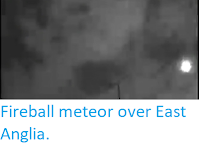The Epsilon Geminid Meteor Shower is visible between 14 and 27 October each year, with peak activity due on the night of Friday 18 October 2019, when 2-3 meteors per hour may be visible. The shower takes its name from the constelation of Gemini, from which the meteors appear to radiate. The Epsilon Geminid Meteor Shower is generally easier to spot in the Northern Hemisphere than the Soiuthern, though it is possible to see the meteors from anywhere on Earth, though viewing will be poor this year as peak activity comes five days after the Full Moon on Sunday 13 October, so that the
meteors may be obscured by the brightness of the Moon.
The radaint point of the Epsilon Geminid Meteor Shower. The Sky Live.
Meteor streams are thought to come from dust shed by comets as they come
close to the Sun and their icy surfaces begin to evaporate away.
Although the dust is separated from the comet, it continues to orbit the
Sun on roughly the same orbital path, creating a visible meteor shower
when the Earth crosses that path, and flecks of dust burn in the upper
atmosphere, due to friction with the atmosphere.The Epsilon Geminid Meteor Shower is caused by the Earth passing through the trail of the Comet C/1964 N1 (Ikeya), and encountering dust from the trail of this comet.
The dust particles strike the atmosphere at speeds of over 250 000 km
per hour, burning up in the upper atmosphere and producing a light show
in the process.
Comet C/1964 N1 (Ikeya) was discovered on 1 August 1963 by Japanese amateur astronomer Kaoru Ikeya. Its name implies that it was the first comet discovered in the first half of August 1963 (period 1963 N), and that it was discovered by Ikeya.
The calculated orbit and current position of C/1964 N1 (Ikeya). JPL Small Body Database.
Comet C/1964 N1 (Ikeya) completes one orbit every 391 years on an eccentric orbit tilted at 172° to the plane of the Solar System, that takes it from 0.82 AU from the Sun (82% of the average distance at which the Earth orbits the Sun) to 106 AU from the Sun (106 times as far from the Sun as the Earth, considerably more than three times the distance at which the planet Neptune orbits the Sun). The comet last visited the Inner Solar System in 1964, and is expected to return agian in 2350. As a comet with an orbital period of more than 200 years it is considered to be a Long Period Comet.
See also...
Follow Sciency Thoughts on Facebook.








